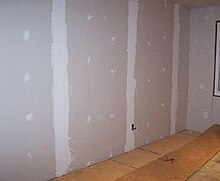

Joint compound (also known as drywall compound, drywall mud, joint cement or mastic) is a white powder of primarily gypsum dust mixed with water to form a paste the consistency of cake frosting, which is spread onto drywall and sanded when dry to create a seamless base for paint on walls and ceilings.[1]
When used for new walls, joint compound effectively eliminates blemishes from the surface of drywall, such as fasteners, damage, or drywall tape. Joint compound is used to finish gypsum panel joints filled with paper or fiber joint tape, corner bead, trim and fasteners, and to skim coat. It is also convenient for patching holes, bumps, tears, and other minor damage to existing walls. In North America, troweling joint mud on gypsum panels is a standard construction technique prior to painting wall and ceiling surfaces.
Joint compound type and formula selection forms part of a drywall system that can be finished anywhere from a level 0 to a level 5, where 0 is not finished in any fashion, and 5 is the most pristine.[2]
A similar compound is used in sprayed-on textural finishing for gypsum panel walls and ceilings that are pre-sealed and coated with a joint compound. Until the last century, several different plasters such as veneer plaster and "plaster of Paris" have been used in similar ways to joint compounds as fillers or for decorative purposes since ancient times, and the actual make up, and working properties of these compounds is much similar.
- ^ "What Is Joint Compound - Drywall Compound Vs Spackle". Plastering Blog. 2016-12-14. Retrieved 2023-05-18.
- ^ "Drywall Finish Levels" (PDF).